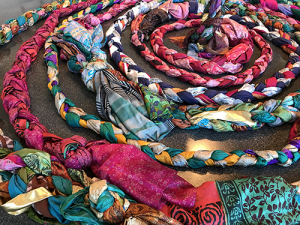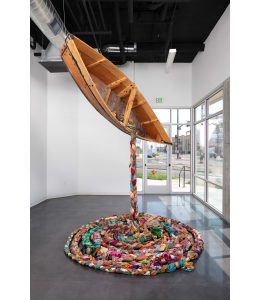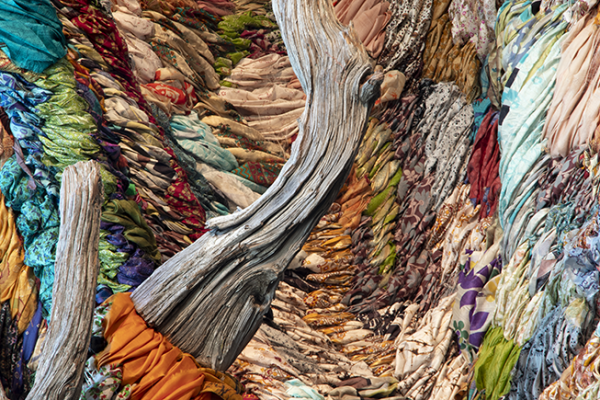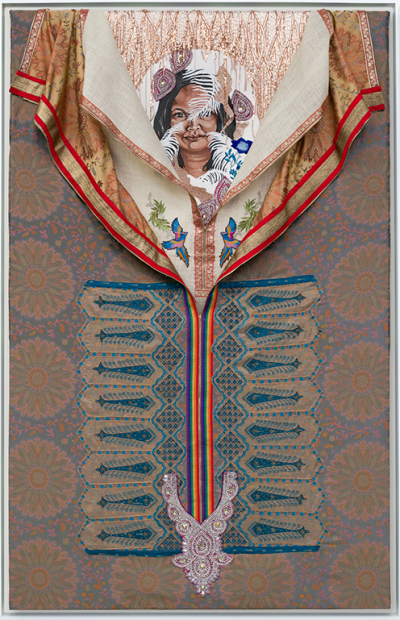Suchitra Mattai: Breathing Room
Using materials often associated with the domestic sphere, such as embroidery, weaving, and fiber elements, Suchitra Mattai creates large-scale installations, sculptures and two-dimensional artworks that navigate her family heritage while also unraveling historical narratives. She reclaims vintage and found materials, such as hand-made saris and other historically rich objects as a way of making sense of the world around her and the multiple cultures she inhabits as an Indo-Caribbean American. By recalling both her own family’s ocean migrations and research on the period of colonial indentured labor during the 19th century, the artist re-writes this colonial history and contributes to contemporary dialogue by giving voice to people whose voices were once quieted and making visible the struggles and perseverance of those who lived through it.
Born in Guyana, Denver-based artist Suchitra Mattai received an MFA in painting and drawing and an MA in South Asian Art, from the University of Pennsylvania, Philadelphia. Mattai also received fellowships to study at the Royal College of Art, London, and at the American Institute of Indian Studies, Udaipur, India. She has exhibited her work in Philadelphia, New York City, Washington, D.C., Denver, Austin, as well as in London, Wales, and Sharjah, UAE.
Organized by the Boise Art Museum
Sponsored by the Pettitt Group at Group One Sotheby’s International Realty and Patty and Alan Head
 |
Patty & Alan |
Suchitra Mattai, who is an American, Caribbean, South Asian artist from Latin America, creates artworks by weaving and braiding vintage saris into three-dimensional sculptures. The saris carry the stories and histories of those who wore them. The artist says about her experience of creating her first woven artwork, “I actually wept making the first one. I felt this connection to these worn garments of people from all over the world. I really felt this connection to those women.” She learned sewing, embroidery, and crocheting from her grandmother and combines these traditional domestic crafts with painting, sculpture, and installation to tell stories about her lineage. The processes of migration, assimilation, and belonging are at the heart of this exploration. “I am interested in ideas of belonging and home because of my family’s many migrations during such a short period of time.”
The Denver-based artist was born in Guyana, South America. Prior to her birth, her family immigrated to Guyana from India to work as indentured servants on a sugar plantation. Her artwork aims to recall her family’s ocean migrations and their perseverance in the face of colonialism, as well as her own experiences living in Canada, the United States, India, and Europe. She purposefully weaves a feeling of disorientation and dislocation related to not having a single home into colorful compositions that are entwined with her family’s histories, personal experiences, and her hopes and dreams for the future.
“Saris are worn by women of South Asian descent all over the world. The weavings, especially on a large scale, as in Breathing Room, unite them. It’s as though I am creating a topography out of the tattered remains of intimate cloth. This work connects diasporic communities of South Asians across the globe, and gives voice to generations of women while also probing questions of displacement resulting from European colonization.”
“…I sense that when I’m making an artwork there are obvious references to women’s work, handmade craft processes, and women’s garb. There is a sense of empowerment that I’m alluding to. When I include heroines, these celebrated women, and everyday girls in my work, there’s a conversation around them that addresses a history of oppression. There’s also a voice, an optimism about the inherent power that they have. I see my practice as a feminist practice, and I see it as a post-colonial practice.”
Videos – Hear from the Artist!
Additional Reading
Examples, Stories, and the History of Saris in India:
15 Variations on the Sari: India’s Iconic Drape – Online Exhibition by The Museum Mumbai (Google Arts and Culture)
Enjoy these literary selections with metaphorical and literal connections to the artwork.
Toddler-Elementary
Bintou’s Braids by Sylvianne Diouf
Qiana’s Braids by Chanda Deanna Austin
Erandi’s Braids by Antonio Hernandez Madrigal
When Mama Braids My Hair Monique Duncan
Hair Twins by Raakhee Mirchandani
Of Corn Silk and Black Braids by Vincent L Johnson
Braids/Trencitas by Kathleen Contreras
La Trenza/The Braid or Lalita’s Journey by Laetitia Colombani
Bear’s Braid by Joelle Bearstail
Young Adult
The Braid by Helen Frost
Adult
You Cannot Resist Me When My Hair Is In Braids by Francis Kai-Hwa Wang
The Braid by Laetitia Colombani
All Ages
How-to Book | Braids: 250 Patterns from Japan, Peru & Beyond by Rodrick Owen
Listen to the artist’s audio guide
Braids can be a metaphor for the power of human connection and a pathway through a journey of escape, healing, or recovery.
Combine paint, fabric, and braiding to create your own work of art!

Suchitra Mattai, Life-Line (detail), 2020, vintage saris, found boat, 12 x 10 ft. Courtesy of the Artist and K Contemporary.




